Introduction
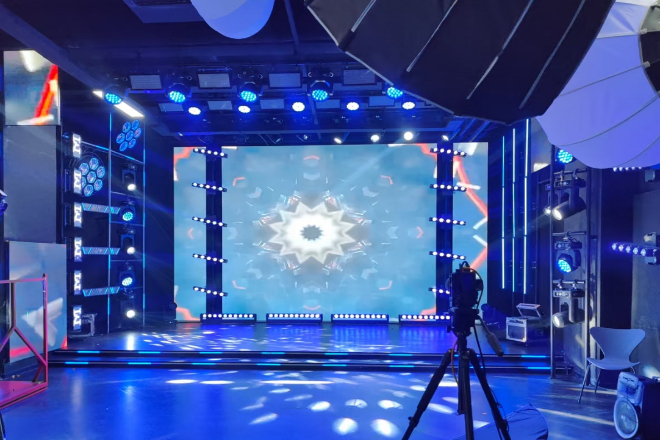
As an indispensable visual display tool in the live broadcast room, the performance and selection of the Écran d'affichage LED directly affect the live broadcast effect and the audience experience.
The control system of the LED display screen, especially the synchronous and asynchronous modes, plays a vital role in the real-time, content diversity and stability of the live broadcast room.
So, is the LED display screen in the live broadcast room suitable for synchronous or asynchronous control systems?
1. The basic principle of synchronous and asynchronous control systems of LED display screens
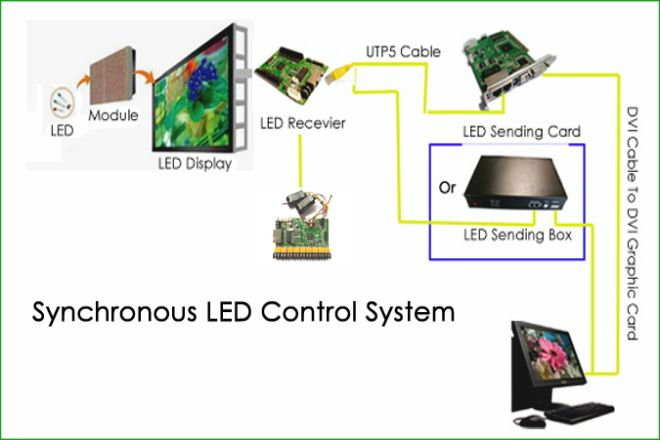
1). Synchronous control system
In simple terms, the synchronous control system makes your LED display screen and computer monitor like “twins” to display content in real-time. Whatever changes on your computer, the LED screen will change accordingly.
This system is actually quite smart. It grabs display data from the computer through a guy called a sending card, and then the data is sent to the receiving card like a courier.
As soon as the receiving card receives the data, it decodes it immediately and displays it on the LED display screen. The whole process is as fast as lightning, ensuring that the picture you see is both synchronous and smooth.
1.1). Components:
Sending card: It is like a messenger, responsible for “packaging” and sending the data to the computer.
Receiving card: Like a courier, it decodes the data immediately after receiving it and displays it on the LED screen.
DVI graphics card:
It is a bridge between the computer and the LED screen, allowing both to “understand” each other’s words.
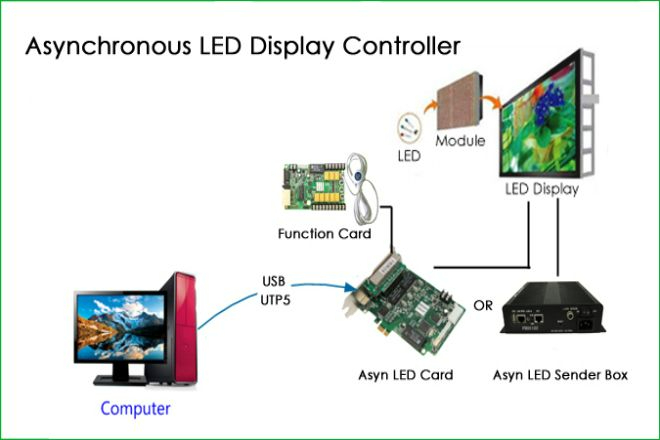
2). Asynchronous control system
The asynchronous control system is much freer, and it does not require the computer to be online all the time. You edit the content you want to display in advance and store it in the system, and the LED screen can display it by itself, even if the computer is turned off.
This system has a memory, like a brain, which records the content you want to display in advance. When it needs to be displayed, the asynchronous control card is like a commander, calling out data from the memory and then letting the LED screen display it. In this way, even if the computer is not around, the LED screen can work by itself.
2.1). Components:
Asynchronous control card: Like a commander, responsible for calling out data from the memory and letting the LED screen display it.
Memory:
Like a brain, it stores all the content you want to display in advance. It can be an SD card, a USB flash drive, or the system’s internal memory.
In general, the synchronous control system is like a follower; it displays whatever the computer displays, while the asynchronous control system is like an independent expert.
It can display the content by itself after saving it in advance. Both have their own advantages and which one to choose depends on your specific needs!
2. Analysis of LED display requirements in the live broadcast room
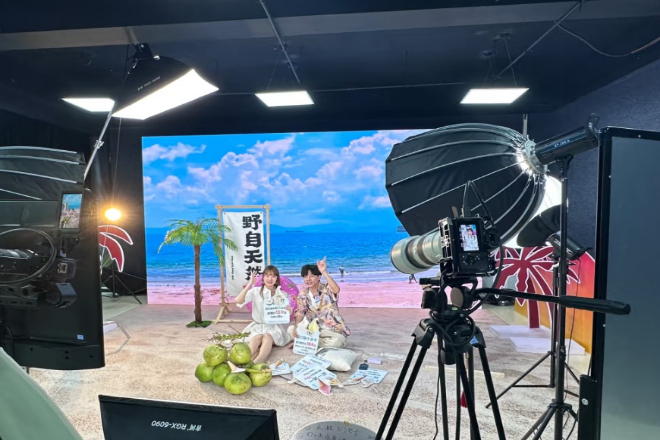
1). Real-time requirements
The live broadcast room is a big stage for real-time interaction! The host’s every move, the audience’s bullet screen likes, and comments must be displayed immediately so that everyone feels like they are on the scene.
The synchronous control system does this. It can capture the content on the computer in real-time and then transfer it to the LED display in a flash. In this way, whether it is the host’s wonderful moments or the audience’s enthusiastic interaction, everyone can see it for the first time, and the atmosphere in the live broadcast room will naturally become hot!
2). Content Diversity
In the live broadcast room, the content is varied, including videos, pictures, text, and various notifications and advertisements. The synchronous control system is like a universal player that can play any content.
High-definition video, dynamic pictures, scrolling text, whatever you want to put. In this way, the anchor can adjust the display content at any time according to the theme and atmosphere of the live broadcast so that the audience can watch with relish, and the live broadcast room will be more attractive!
3). Stabilité et fiabilité
When broadcasting live, the most feared thing is the screen freeze and delay, which can be very frustrating! The synchronous control system transmits data very quickly and is very stable. Even if there are some minor problems sometimes, they can recover quickly to ensure the smooth progress of the live broadcast.
Choose a better LED display and synchronous control system, which are reliable in quality and will not be afraid of problems no matter how long they are used. In this way, the audience can always enjoy a smooth live broadcast experience, and the anchor can live broadcast with peace of mind without worrying about technical failures!
3. Comparative analysis of synchronous and asynchronous applications in live broadcast rooms
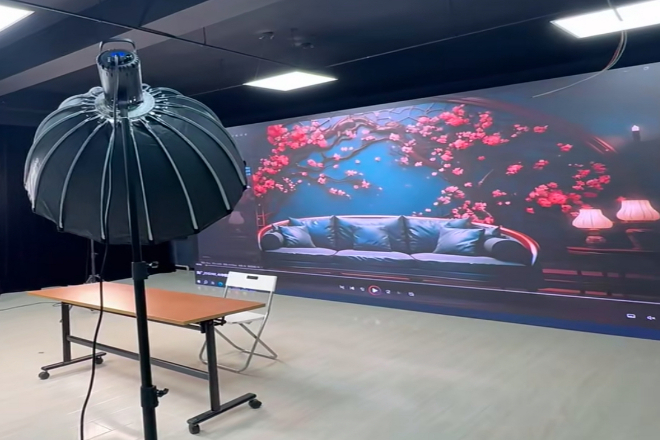
1). Advantages and disadvantages of synchronous system
1.1). Advantages
The synchronous system is simply the “real-time announcer” of the live broadcast room! Its real-time performance is super high. Once the content on the computer is updated, it can be displayed immediately on the LED display. Delay?
There is no such thing! Moreover, the synchronous system is also very expressive. It can display anything, such as videos, pictures, and text, and the picture effect is great. The most amazing thing is that it is very flexible.
The anchor can switch any picture he wants, and can adjust it according to the needs of the live broadcast anytime and anywhere. It is so convenient!
1.2). Disadvantages
However, the synchronous system also has its “little temper.” Because it pursues real-time performance too much, the requirements for the network and equipment are relatively high.
Once the network is unstable or the equipment fails, it may cause the picture to freeze or delay, affecting the audience’s viewing experience.
Moreover, the synchronous system usually requires a high-cost investment, including hardware equipment and network bandwidth, which may be a considerable burden for some small live broadcast rooms.
2). Advantages and disadvantages of asynchronous systems
2.1). Advantages
The asynchronous system also has its unique features. Since it does not require real-time data transmission, the requirements for the network are relatively low, and the stable display of the content can be guaranteed even in poor network conditions.
Moreover, the cost of the asynchronous system is relatively low, which is suitable for some live broadcast rooms with limited budgets.
In addition, the asynchronous system also has the function of content pre-examination, which can be reviewed and modified before the content is played to ensure that the broadcast content meets relevant regulations and requirements. This is undoubtedly a plus for some live broadcast rooms that focus on content quality.
2.2). Disadvantages
However, compared with the synchronous system, the asynchronous system is a bit like a “slow” player. It cannot display the content on the computer in real-time, and there is always a little delay, which is a big problem for live broadcast rooms that pursue real-time interaction.
Moreover, the expressiveness of the asynchronous system is also limited. It can only support the display of text and simple graphics. Do you want to play a video or a dynamic picture? That will take some effort. In addition, its flexibility is relatively poor.
The content must be stored in advance and the screen cannot be switched in real time. This is a big limitation for live broadcast rooms with many changes.
3). Specific application scenarios
So, where should the synchronous system and asynchronous system be used? In fact, it depends on the specific needs.
Because of its high real-time performance, strong expressiveness and good flexibility, the synchronous system is particularly suitable for live broadcast rooms with high real-time requirements, such as live broadcasts of sports events and concerts.
The audience does not want to miss any exciting moments! As for the asynchronous system, although it lacks real-time performance, limited expressiveness, and poor flexibility, it also has its own place.
For example, outdoor advertising screens and bus station information screens have relatively fixed content and do not need to be updated in real-time. It is quite suitable to use asynchronous systems, which are both economical and practical.
4. Suggestions for the selection of control systems for LED display screens in live broadcast rooms
1). Give priority to synchronous systems
As we all know, the live broadcast room is a big stage for real-time interaction. The host’s every move, as well as the audience’s bullet screens and likes, must be displayed immediately so that there is an atmosphere.
Therefore, when choosing a control system for an LED display screen, the synchronous system is definitely the first choice.
It can display the host’s screen and interactive information in real-time so that everyone in the live broadcast room can feel the instant excitement and interaction. Moreover, the picture expressiveness of the synchronous system is also superb.
It can display high-definition videos, dynamic pictures, and everything else, making the live broadcast room look even cooler!
2). Consider cost and budget
Of course, when choosing something, you can’t just look at the performance; you also have to look at whether your wallet is full. Although the synchronous system is good, the price is usually relatively high.
When choosing a control system in a live broadcast room, you have to base it on your budget and needs. If the budget is sufficient and you pursue high-quality live broadcast effects, then the synchronous system will definitely be fine.
But if the budget is limited, you have to weigh it carefully to see if you can find a more cost-effective solution.
3). Comprehensive evaluation and selection
Choosing an LED display control system is not a simple matter. In addition to real-time performance and cost, you also have to consider factors such as expressiveness and stability. Expressiveness means that the picture should look clear and dazzling.
Stability means that there should be no problems, such as freezes and delays during the live broadcast. Therefore, when choosing the live broadcast room must comprehensively consider all these factors and select the most suitable control system according to its specific application scenarios and needs.
Don’t blindly follow the trend, and don’t be greedy for small profits. Only by choosing the right one can you use it comfortably and the live broadcast effect can be awesome!
Conclusion
In summary, synchronous and asynchronous control systems have their own advantages in the application of LED displays in live broadcast rooms.
However, considering the high requirements of the live broadcast room for real-time, content diversity, and stability, the synchronization system can better meet the needs of the live broadcast room with its advantages of high real-time, rich expression, and good flexibility.
Of course, when choosing the LED display control system, we also need to comprehensively consider factors such as cost, budget and specific application scenarios of the live broadcast room.
Enfin, si vous souhaitez en savoir plus sur les écrans LED, veuillez nous contacter.
